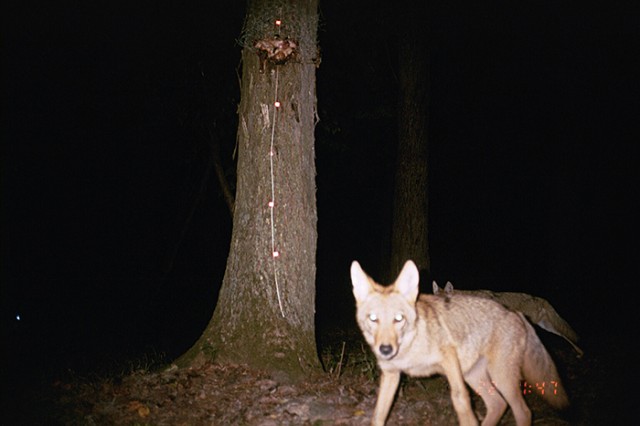People, Pets and Coyotes Collide

Residents reported 740 coyote sightings or incidents in the year that ended Sept. 30. Photo courtesy of Smithsonian Wild/Flickr
Correction: This story has been changed to correctly identify Ted Dietz as an Austin-area resident.
By Helen Fernandez
For Reporting Texas
Ted Dietz found only fur, innards and bones on his front lawn after a pair of coyotes ate his cat.
Dietz’s dogs barked a lot more than usual that night. When the Austin-area resident let them out into the front yard, the dogs sprinted back inside with fear. Dietz ran inside to get his flashlight, but the coyotes had already attacked.
“In 45 seconds they grabbed parts of my cat and took off…. They gutted her and devoured her right there at the bottom of the tree,” Dietz said.
Growth in the Austin area is a problem for wild animals. With nowhere to go, coyotes adapt to living in the city. Wildlife experts say encounters between people, pets and coyotes are on the rise.
The city of Austin is considering a humane management plan for urban coyotes that was proposed by the Austin Animal Advisory Commission.
The current draft of the resolution emphasizes education for the public and non-lethal ways to drive coyotes out of neighborhoods, said Ben Leffler, policy aide for council member Chris Riley.
The committee also suggested more humane methods of trapping and killing coyotes. The draft bans the use of leg-hold traps, neck snares and poison at all times. Trapping will only be permitted “in the event of an attack on a pet or an attack on a human,” Leffler said.
The advisory commission passed the draft on Oct. 8 in a 4-2 vote. The City Council’s Public Health and Human Services Committee later approved the recommendation unanimously, and the item is on the agenda for the full council’s meeting on Thursday.
A possible vote on the recommendation comes at a time when coyote sightings are on the rise.
Austin had 740 coyote sightings or incidents during the year ending on Sept. 30, said Stefan Hunt, a biologist with the U.S. Department of Agriculture’s Wildlife Services. Coyotes killed 44 pets at night and 17 during the day.
A total of 61 coyotes were euthanized. Of those, 33 coyotes were euthanized on farms and ranches because they were killing livestock. The remaining 28 were euthanized in Austin. “We take less than 10 percent every year,” Hunt said.
Carol Bannerman, a spokeswoman for wildlife services, said the number of coyote sightings and reports have increased but that her agency did not have numbers for previous years.
Wildlife services has separate programs to remove coyotes from urban and rural areas. Coyotes are trapped only if they display aggressive behavior.
“Seeing coyotes does not have to be a concern; rather, the behavior seen is important,” Bannerman said. Wildlife services uses a 0-7 scale to measure coyote behavior. A wandering coyote might get a score of 4.
“Chasing or taking pets from residential streets or yards” would earn a coyote a 5. Acting aggressively toward an adult midday would earn it a 7.
“For the calls that score 0-4, we provide education to the resident,” Hunt said. Texas Wildlife provides pamphlets to help residents deal with coyotes.
“For calls that score 5 and above, we try to implement trapping if it is safe to do so,” Hunt said. After the coyote is captured, it will then be euthanized.
Austin isn’t the only city with an increasing coyote population.
Houston has seen more coyotes because “we’re encroaching more and more on their territory,”said Ramon Cardenas, owner of Houston Critter Control, a private animal control company. Houston Critter Control uses humane leg traps that are more like collars. They do not choke the coyote, but they are euthanized once they are captured.
The Texas Department of State Health Services calls for euthanizing any coyote that appears to have rabies. The agency recommends not damaging the coyote brain so it can be examined for rabies.
State law allows anyone to kill a coyote if it is attacking livestock, humans or domestic animals.
Austin is seeing more coyotes because their habitat is shrinking. But Hunt said he believes that coyotes are “taking advantage of us more than we are running them out.”
“We offer a lot of water sources, a lot of shelter for them,” Hunt said. People shouldn’t leave out food and water if they don’t want coyotes on their property, he said.
Austin resident Rachel Hirsh said she would like to see more of a response from authorities.
Not that long ago, she came face to face with a coyote while she was walking her dog.
“It was running down toward us. It was very close. When I saw it and my brain processed that it was a coyote and not another dog, I began waving my arms and yelling. My dog cowered,” Hirsh said.
“Running down a residential street toward a person and their dog” seemed like very aggressive behavior to Hirsh. She called 311 but never heard back, Hirsh said.